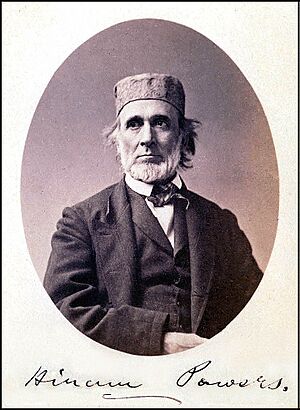Hiram Powers facts for kids
Hiram Powers (born July 29, 1805 – died June 27, 1873) was an American sculptor. He created art in the Neoclassical style, which looked back to the art of ancient Greece and Rome. Powers was one of the first American artists in the 1800s to become famous around the world. He was especially known for his marble statue called The Greek Slave.
Contents
Early Life and Learning About Art
Powers was born on July 29, 1805, in Woodstock, Vermont. His family were farmers. When he was 14, his family moved to Ohio, near Cincinnati. Hiram went to school for about a year while living with his uncle.
After his parents passed away, he started working. First, he managed a reading room at a hotel. Then, he worked as a clerk in a general store. When he was 17, Powers became an assistant to Luman Watson. Watson owned a factory in Cincinnati that made clocks and organs. Hiram was very good at making figures and became the best mechanic in the factory.
In 1826, he started visiting the studio of Frederick Eckstein. There, he discovered a strong love for sculpting. Because he was skilled at modeling figures, he got a job at the Western Museum. This museum was run by Joseph Dorfeuille, a naturalist from Louisiana. At the museum, Powers created scenes from Inferno, a famous poem by Dante. These scenes were very popular. Fanny Trollope, a writer, helped him start his career by having him sculpt scenes from Dante's Divine Comedy. After learning a lot about modeling and casting, he moved to Washington, D.C. in late 1834.
Becoming a Famous Sculptor
In Washington, D.C., Powers became well-known for his sculpted portrait of Andrew Jackson, who was president at the time. In 1837, Powers moved to Florence, Italy. He chose Florence because it had good supplies of marble. It also had a long history of stone carving and bronze casting. He stayed in Florence for the rest of his life, though he did visit Britain once. In Italy, he became good friends with another sculptor, Horatio Greenough.
Powers became very busy making portraits of people. He also created "fancy" busts, which were sculptures of a person's head and shoulders. But he also spent time making life-size statues of ideal figures. Many of these full figures were also made into busts. In 1839, his statue of Eve was admired by Bertel Thorvaldsen, a leading European sculptor.

In 1843, Powers created his most famous statue, The Greek Slave. This artwork immediately made him one of the top sculptors of his time. When it toured America in 1847, more than 100,000 people came to see it. In 1851, it was shown in Britain at the Crystal Palace Exhibition. The poet Elizabeth Barrett Browning even wrote a poem about it. This sculpture also became important in the fight to end slavery in America. Copies of it were displayed in many state houses that supported the Union during the American Civil War.
Some of his other well-known ideal statues include The Fisher Boy, Il Penseroso, Eve Disconsolate, California, America, and The Last of the Tribe. In 1851, he was chosen as an Associate Fellow of the American Academy of Arts and Sciences.
One of Powers' most important clients was Prince Anatole Demidoff. The Prince owned marble versions of both the Greek Slave and the Fisher Boy. He also asked Powers to sculpt a portrait of his wife. The statues and busts Powers made for Demidoff were special because of the high quality of the marble.
Hiram Powers also taught at the Florence Accademia, an art school. One of his sons, Preston Powers, also became a sculptor. Hiram Powers passed away on June 27, 1873. He is buried in the English Cemetery in Florence, Italy.
Where to See His Art
In 2007, the Taft Museum of Art in Cincinnati, Ohio, held a big exhibition of Hiram Powers' work. It was called "Hiram Powers: Genius in Marble." This was the first major show dedicated to his art. The same museum also hosted Powers' first solo exhibition in Cincinnati back in 1842. At that time, Nicholas Longworth opened his home to let the public see Powers' newest sculptures.
Many art museums and collections around the world have works by Hiram Powers. Some of these include the Metropolitan Museum of Art in New York City, the National Gallery of Art in Washington D.C., the Museum of Fine Arts, Boston, and the Smithsonian American Art Museum. His sculptures can also be found in the White House Collection and the Vermont State House Fine Arts Collection.
Gallery
-
President Andrew Jackson, made in 1835
-
Benjamin Franklin, 1844–60
See also
 In Spanish: Hiram Powers para niños
In Spanish: Hiram Powers para niños






